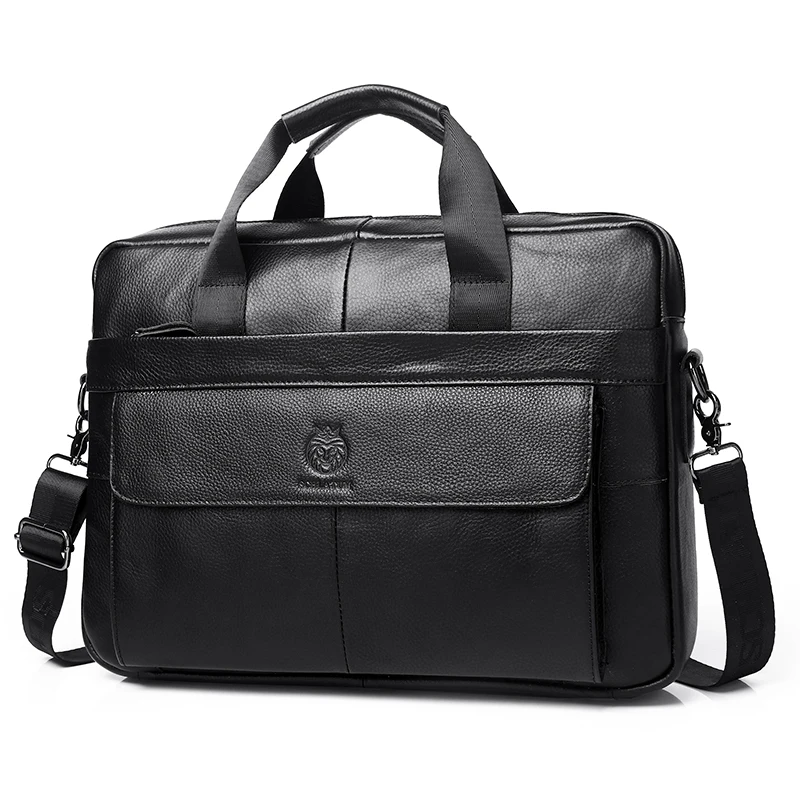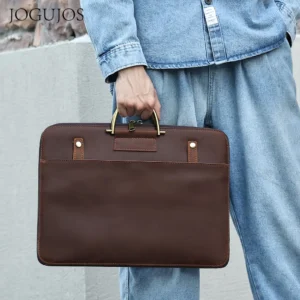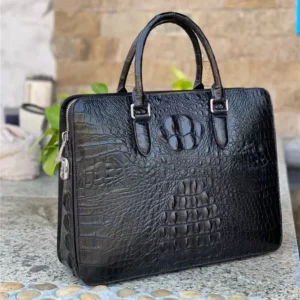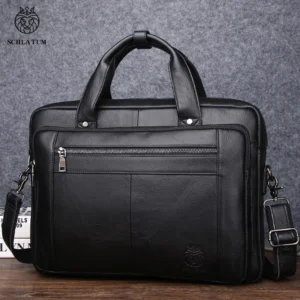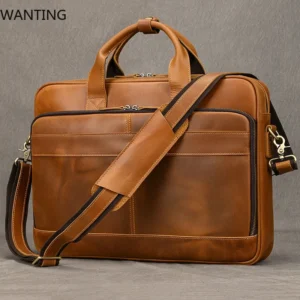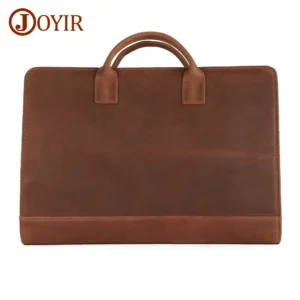Understanding the Value of Scratch Prevention for Leather Briefcases
A premium leather briefcase represents more than just a way to carry your work essentials—it’s an investment in your professional image and a companion that can last for decades with proper care. When you purchase a quality leather briefcase, you’re investing in a piece that typically costs several hundred dollars or more, with the expectation that it will serve you well for years to come.
Scratches on leather don’t just diminish the aesthetic appeal of your briefcase; they can significantly reduce its resale value and shorten its useful lifespan. The relationship between care and longevity is direct: a well-maintained leather briefcase might accompany you throughout your entire career, while a neglected one might need replacement after just a few years.
The key to maintaining your briefcase’s pristine condition lies in prevention rather than repair. Proactive care offers several advantages:
- It preserves the original appearance and texture of the leather
- It maintains the structural integrity of the briefcase
- It prevents minor issues from developing into major damage
- It enhances the natural patina that develops over time, rather than detracting from it
In this comprehensive guide, we’ll explore how to protect your investment through understanding leather properties, daily handling practices, proper cleaning, conditioning, and strategic storage. With these techniques, you’ll be equipped to keep your timeless classic leather briefcase looking professional for years to come.
For professionals seeking to make a worthwhile investment, our collection of classic leather briefcases offers options that combine durability with timeless style.
Understanding Leather Properties and Scratch Vulnerability
The Natural Characteristics of Leather
Leather is a remarkable material with seemingly contradictory properties: it’s simultaneously durable and delicate. As a natural material derived from animal hide, leather possesses a porous structure that gives it flexibility, breathability, and character. However, this same quality makes it vulnerable to environmental factors and physical damage.
Much like human skin, leather needs moisture and protection to remain supple and resistant to damage. Without proper care, it can dry out, crack, and become increasingly susceptible to scratches and abrasions.
Different Leather Types and Their Scratch Resistance
Not all leather briefcases offer the same level of scratch resistance. The type of leather used significantly affects both durability and how visible scratches will be:
Full-grain leather: The highest quality and most durable option, featuring the entire grain surface with all natural markings. While extremely long-lasting, it does show scratches more readily, though it develops a beautiful patina over time.
Top-grain leather: Created by sanding away imperfections from full-grain leather, offering a good balance between durability and scratch resistance. The slightly processed surface tends to hide minor scratches better than full-grain.
Corrected-grain leather: More heavily processed for uniformity, with an applied finish that offers better initial scratch resistance but less natural character and reduced long-term durability.
Bonded leather: Made from leather scraps bonded together with adhesives, this is the least durable option and more prone to peeling and damage over time, despite initial scratch resistance.
How Finishing Affects Vulnerability
The finish applied to leather significantly impacts its scratch resistance:
Aniline leather: Minimally treated with only dye and no surface coating, showing the most natural look but offering the least scratch protection.
Semi-aniline leather: Features a light protective coating that balances natural appearance with improved scratch resistance.
Pigmented leather: Coated with a layer containing pigments and protective sealants, providing the highest scratch resistance but a less natural feel.
Understanding these different leather types and qualities helps explain why some briefcases develop scratches more easily than others. It also explains why certain care techniques are more effective for specific types of leather.
Many professionals appreciate how full-grain leather bags develop unique character over time, with minor scratches and wear actually contributing to an appealing patina that tells the story of your professional journey.
Common Causes of Scratches on Leather Briefcases
Being aware of what typically causes scratches is the first step in preventing them. Here are the most common culprits:
Everyday Objects
- Keys and metal items: When placed in the same compartment as your briefcase or carried alongside it, keys can easily create deep scratches.
- Zippers and hardware: The metal components of the briefcase itself can scratch the leather surface if they rub against it repeatedly.
- Jewelry and watches: Rings, bracelets, and watch clasps often have sharp edges that can inadvertently mark leather when handling your briefcase.
- Office supplies: Paper clips, staples, and even the spiral binding of notebooks can create surface scratches.
- Rough-textured desks and tables: Surfaces with slight imperfections, splinters, or rough patches can abrade leather when the briefcase is slid across them.
Behavioral Factors
- Improper storage: Stacking heavy items on top of your briefcase or cramming it into tight spaces puts pressure on the leather and increases scratch risk.
- Overstuffing: When a briefcase is packed beyond capacity, the leather stretches and becomes more vulnerable to abrasion and stress marks.
- Careless placement: Setting your briefcase on concrete sidewalks, asphalt parking lots, or dirty floors introduces both scratches and stains.
- Rushed handling: Quickly grabbing your briefcase by any available part rather than using handles or straps can cause fingernail scratches or strain.
- Transportation hazards: Sliding around in car trunks or getting bumped in public transit can expose your briefcase to numerous scratching opportunities.
Even something as simple as placing your briefcase next to a wall with a rough texture or brushing against someone else’s bag in a crowded elevator can result in noticeable scratches if you’re not careful.
For professionals seeking briefcases with thoughtful design features that minimize scratch vulnerability, our men’s classic leather briefcase collection offers options with protective elements and durable construction.
Essential Daily Handling Practices for Scratch Prevention
The way you handle your briefcase each day has the greatest impact on preventing scratches. Incorporate these practices into your routine for optimal protection:
Use designated handles and straps only: Always pick up your briefcase by its intended carrying points rather than grabbing the body, which can cause stress on the leather and potential fingernail scratches.
Be mindful of jewelry: Remove or be conscious of rings, watches, or bracelets that might scratch the surface when handling your briefcase. Consider making it a habit to use your non-jewelry hand when possible.
Create buffer zones: Avoid direct contact between your briefcase and potentially damaging items. For example, carry keys in your pocket rather than alongside your briefcase.
Practice proper placement: Always place your briefcase on clean, smooth surfaces. If uncertain about a surface, use a small cloth or even a newspaper as a protective barrier.
Maintain awareness in transit: In crowded spaces, hold your briefcase slightly in front of you or close to your body to prevent it from bumping against others’ belongings or environmental hazards.
Open and close with care: Use both hands when opening clasps or zippers to minimize stress and prevent the hardware from scratching the leather surface.
Monitor internal pressure: Organize contents to distribute weight evenly and avoid overpacking, which can create pressure points where scratches are more likely to occur.
Use consistent entry points: Develop the habit of always placing small items in the same pockets or compartments to minimize unnecessary opening and closing of various sections.
These simple yet effective daily maintenance routines can dramatically reduce the risk of scratches without requiring any special products or treatments. The key is developing these protective habits until they become second nature.
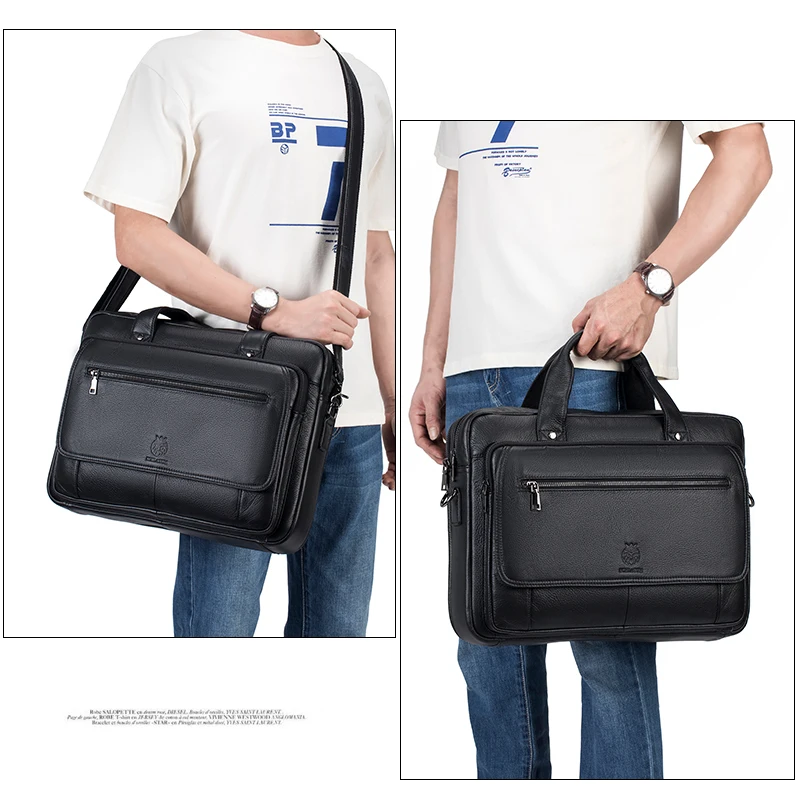
Regular Cleaning: Removing Abrasive Particles
Dust and dirt particles might seem harmless, but they act as microscopic sandpaper when they rub against your leather briefcase. Regular cleaning removes these abrasive particles before they can cause damage.
Basic Cleaning Routine
Step 1: Dusting
Begin with a gentle dusting using a soft, dry microfiber cloth or a soft-bristled brush. Pay special attention to seams, corners, and hardware areas where particles accumulate. Work in small, circular motions to lift dust rather than pressing it into the leather.
Step 2: Light Cleaning
For a more thorough clean:
– Slightly dampen (not wet) a clean microfiber cloth with distilled water
– Gently wipe the leather surface in small sections
– Follow immediately with a dry cloth to remove any moisture
– Allow the briefcase to dry completely at room temperature
Step 3: Focus on Problem Areas
Pay extra attention to handles, edges, and areas that make frequent contact with hands or surfaces, as these collect more oils and dirt.
Cleaning Frequency
The optimal cleaning schedule depends on usage:
– Daily use: Dust with dry cloth 1-2 times weekly; deeper clean monthly
– Weekly use: Dust bi-weekly; deeper clean every 2-3 months
– Occasional use: Dust monthly; deeper clean quarterly
For unexpected spills or stains, address them immediately rather than waiting for your next scheduled cleaning. Blot (don’t rub) any liquid spills with a clean, dry cloth before they can penetrate the leather.
By incorporating regular cleaning into your maintenance routine, you’re not just preventing scratches but also preserving the leather’s natural oils and preventing compound damage from environmental factors. For more specific techniques on handling different cleaning scenarios, our definitive guide to cleaning and maintaining office leather bags provides detailed instructions.
For stubborn marks that normal cleaning won’t address, our guide on cleaning stains from leather bags offers specialized approaches without risking damage to the leather.
Conditioning: Enhancing Leather’s Natural Scratch Resistance
Well-hydrated leather is naturally more resilient against scratches. Conditioning replenishes essential oils that keep leather supple, allowing it to better withstand daily wear and minor abrasions.
Selecting the Right Conditioner
The type of leather determines which conditioner works best:
– For full-grain and top-grain leather: Choose natural-based conditioners with lanolin, beeswax, or neatsfoot oil
– For treated or pigmented leather: Use lighter conditioners specifically formulated for finished leather
– For suede or nubuck: Skip traditional conditioners and use only products specifically designed for these delicate surfaces
Avoid silicone-based products, as they can seal the leather too tightly and prevent natural breathing, leading to dryness and cracking over time.
Step-by-Step Conditioning Process
Preparation:
1. Clean the briefcase thoroughly and allow it to dry completely
2. Test the conditioner on an inconspicuous spot (like the bottom) to check for any darkening or adverse reactions
3. Wait 24 hours to see the final result of your test before proceeding
Application:
1. Apply a small amount of conditioner to a soft, lint-free cloth (never directly onto the leather)
2. Work in small sections, using gentle circular motions
3. Apply thinly and evenly—more is not better with leather conditioning
4. Pay extra attention to high-flex areas like handles and edges
5. Allow to absorb for 10-15 minutes (follow product instructions)
Finishing:
1. Gently buff away any excess conditioner with a clean cloth
2. Allow the briefcase to rest for 24 hours before heavy use
3. Assess if a second light application is needed for very dry leather
Conditioning Frequency
The optimal conditioning schedule depends on both climate and usage:
– Typically: Every 3-4 months for regularly used briefcases
– Dry climates: Every 2-3 months to combat moisture loss
– Humid climates: Every 4-6 months to prevent over-moisturizing
– After heavy rain exposure: Condition once fully dry to replenish lost oils
Warning signs that your leather needs conditioning include a dry appearance, slight stiffness when flexed, or leather that scratches more easily than usual.
A well-conditioned briefcase not only resists scratches better but also develops a rich patina over time. Our classic laptop briefcase collection features designs worthy of this level of care, with leather that responds beautifully to proper conditioning.
Protective Treatments: Creating a Shield Against Scratches
While conditioning moisturizes leather from within, protective treatments create an external barrier against scratches, stains, and environmental damage. They act as a sacrificial layer, absorbing minor abrasions that would otherwise mark the leather itself.
Types of Leather Protectants
Cream-Based Protectants
– Best for: Full-grain and top-grain leather with natural finish
– Benefits: Deep protection, enhances leather’s natural oils
– Application: Apply with soft cloth in thin, even layer
– Durability: Generally lasts 2-3 months with regular use
Spray-On Protectors
– Best for: All leather types, especially convenient for large surfaces
– Benefits: Even application, water and stain resistance
– Application: Spray evenly from recommended distance (usually 6-8 inches)
– Durability: Typically needs reapplication every 4-8 weeks
Waxes and Balms
– Best for: Vintage or high-quality full-grain leather
– Benefits: Highest level of scratch protection, water resistance
– Application: Apply sparingly with fingers or cloth, buff thoroughly
– Durability: Can last 3-6 months depending on formula and use
Application Guidelines
For optimal protection regardless of product type:
1. Always clean and condition leather before applying protectant
2. Apply in thin layers—multiple light coats are better than one heavy application
3. Allow full drying time between coats (usually 24 hours)
4. Pay special attention to high-contact areas like corners and handles
5. Buff thoroughly after application for cream or wax products
Reapplication Schedule
The protection layer gradually diminishes with use, requiring periodic renewal:
– High-use briefcases (daily commuting): Every 4-6 weeks
– Moderate use: Every 2-3 months
– Light use: Every 6 months
– Always reapply after cleaning or exposure to harsh conditions
Beyond scratch resistance, these protectants offer additional benefits like protection from rain damage and UV protection, which can prevent fading and drying. This multi-layered approach ensures your briefcase maintains its professional appearance through various environmental challenges.
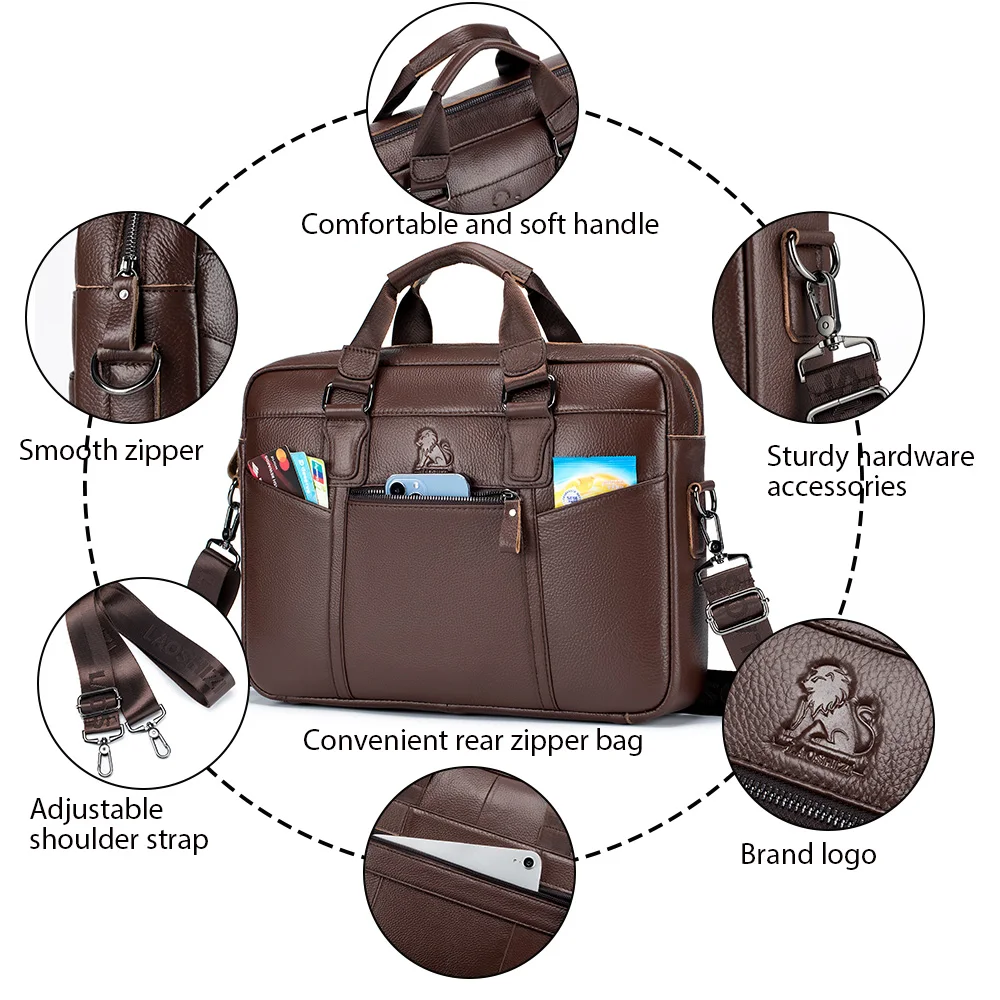
Strategic Storage to Prevent Scratches When Not in Use
How and where you store your leather briefcase when not in use plays a crucial role in preventing scratches and maintaining its condition.
Optimal Storage Environment
- Temperature: Store in a cool, consistent environment (60-75°F / 15-24°C)
- Humidity: Maintain moderate humidity (40-50%) to prevent drying or mildew
- Light exposure: Avoid direct sunlight, which can fade and dry leather
- Air circulation: Allow some airflow rather than airtight storage
Protective Covering
- Use the original dust bag whenever possible
- If unavailable, a cotton pillowcase makes an excellent alternative
- Avoid plastic covers, which trap moisture and prevent leather from breathing
- For long-term storage, use acid-free tissue paper to stuff the briefcase and maintain its shape
Positioning and Pressure Points
- Store upright rather than flat when possible to maintain shape
- Avoid stacking heavy items on top of your briefcase
- Keep away from sharp objects and rough surfaces
- Ensure hardware doesn’t press against the leather body
Long-Term Storage Preparation
If storing for months or seasons:
– Clean and condition thoroughly before storage
– Stuff with acid-free paper to maintain shape and prevent creasing
– Keep in a breathable bag in a dark, dry closet
– Check occasionally for signs of mold or dryness
When selecting your next leather briefcase, look for designs with features that enhance scratch resistance and ease of storage. Our guide to choosing the perfect leather briefcase highlights important design elements that contribute to long-term durability.
On-the-Go Protection Strategies
Even the most careful professional encounters challenging environments during daily commutes and travel. These strategies will help protect your briefcase in various on-the-go scenarios:
Public Transportation Protection
- Hold your briefcase on your lap when seated rather than placing it on the floor
- In standing-room-only situations, position your briefcase between your feet or hold it against your body
- When using overhead racks, place your briefcase with hardware facing inward and leather surfaces away from potential contact with other items
- Consider a simple protective sleeve for crowded commutes on buses or trains
Vehicle Safety
- Avoid placing your briefcase on the car floor where it might slide during stops
- Use the rear footwell or dedicated seat (with seatbelt if possible) rather than the trunk
- Keep your briefcase away from potentially damaging items like umbrellas or shoes
- Be mindful of temperature extremes in parked cars, which can damage leather
Weather Considerations
- Use a rain cover during precipitation—even brief exposure can cause water spots
- Shield your briefcase from direct sunlight when walking outdoors
- In winter, avoid contact between your briefcase and salt-treated sidewalks or roads
- Allow wet briefcases to dry naturally at room temperature before storage
High-Traffic Environments
- Be particularly mindful when moving through doorways or crowded spaces
- In elevators or small meeting rooms, hold your briefcase rather than setting it down
- At coffee shops or restaurants, choose chair-side placement rather than floor storage
- When traveling through airports or train stations, be aware of rolling luggage that might bump your briefcase
For professionals who frequently travel with important documents, our leather document bag collection offers designs with additional protective features for on-the-go use.
Addressing Minor Scratches: Immediate Interventions
Despite best preventive efforts, scratches occasionally happen. The good news is that many minor scratches can be addressed with simple techniques if caught early.
Assessing Scratch Severity
Before attempting any fix, determine what you’re dealing with:
Surface Scuffs: Light marks that haven’t penetrated the finish layer, appearing as faint lines that catch the light
Shallow Scratches: Visible lines that have broken the finish but not deeply penetrated the leather
Deep Scratches: Obvious marks that have cut into the leather itself, possibly exposing lighter-colored material underneath
Quick Fixes for Surface Scuffs and Shallow Scratches
The Finger Technique:
1. Thoroughly clean and dry the affected area
2. Gently rub the scratch with a clean fingertip in circular motions
3. The natural oils from your skin and the generated heat help redistribute the leather’s oils to “heal” minor marks
4. Continue for 30-60 seconds, then leave overnight
Leather Balm Method:
1. Clean the area with a slightly damp cloth and let dry
2. Apply a tiny amount of leather conditioner or balm to your fingertip
3. Gently work into the scratch using small circular motions
4. Allow to absorb, then buff with a soft cloth
5. Repeat if necessary after 24 hours
Buffing Solution:
1. Clean the area thoroughly
2. Use a soft, dry microfiber cloth to buff the area with moderate pressure
3. Work in circular motions to smooth the fibers and redistribute oils
4. For slightly more abrasive needs, use a specialized leather buffing cloth
When to Seek Professional Help
Consider professional leather repair services when:
– Scratches penetrate deeply into the leather
– The color has been removed from a significant area
– The scratch affects a highly visible portion of your briefcase
– Multiple attempted fixes haven’t produced satisfactory results
Remember that some marks eventually blend into the natural patina of quality leather. This character development is part of what makes durable leather briefcase options so appealing over time—each mark tells a story of your professional journey.
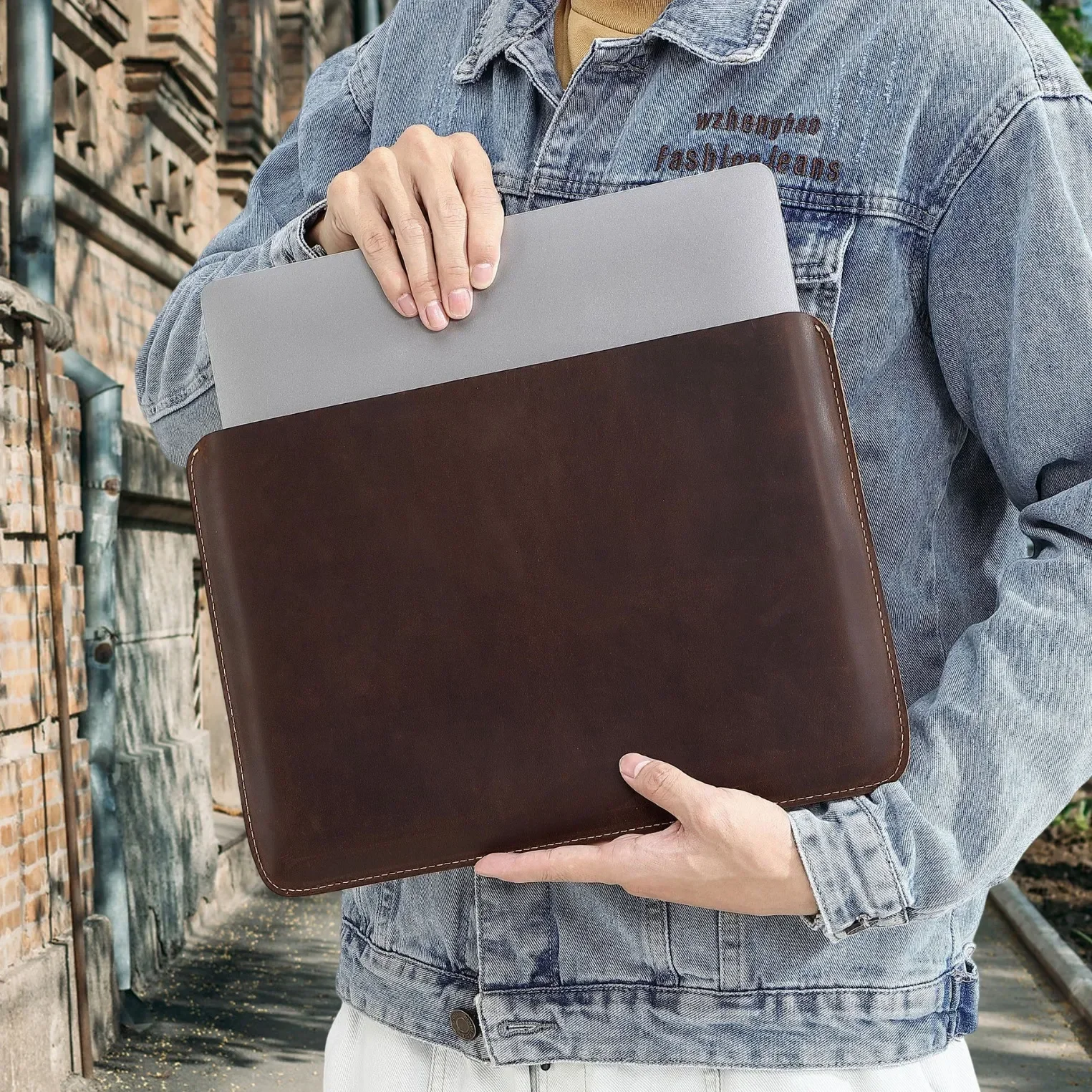
Creating a Comprehensive Care Routine
Combining all the preventive strategies into a consistent routine ensures your briefcase remains scratch-free and beautiful for years to come. Here’s a practical maintenance schedule to follow:
Daily Practices (1-2 minutes)
- Use proper handling techniques
- Store in dust bag or proper location when not in use
- Quick inspection for new marks or damage
- Wipe with dry microfiber cloth if exposed to dust or light debris
Weekly Tasks (5-10 minutes)
- Thorough dusting with soft brush or cloth
- Inspect hardware and stress points
- Address any new minor scuffs using finger technique
- Ensure proper stuffing to maintain shape during weekend storage
Monthly Care (15-20 minutes)
- Complete cleaning with appropriate leather cleaner
- Check for areas needing conditioning
- Assess protective coating effectiveness
- Inspect and clean interior compartments
Seasonal Maintenance (30-45 minutes)
- Deep conditioning treatment
- Reapplication of protective products
- Hardware maintenance (gentle tightening if needed)
- Thorough inspection of stitching and structure
Tracking System
Keep a simple note in your phone or calendar with:
– Last conditioning date
– Last protectant application
– Any special treatments applied
– Areas to monitor from previous damage
This systematic approach ensures no aspect of care is overlooked while making maintenance manageable. Adjust the frequency based on your usage patterns—daily commuters in varied weather conditions need more frequent care than those who use their briefcase occasionally.
Men's Classic Leather Briefcase, Slim Leather Laptop Briefcase, Slim Leather Portfolio Briefcase
$93.67 Select options This product has multiple variants. The options may be chosen on the product pageClassic Laptop Briefcase, Men's Classic Leather Briefcase, Slim Leather Attache Case
Price range: $353.50 through $360.81 Select options This product has multiple variants. The options may be chosen on the product pageBlack Leather Briefcase, Leather Document Bag, Men's Classic Leather Briefcase
Genuine Crocodile Leather Executive Briefcase with Password Lock – Premium Business Document Carrier$1,201.87 Select options This product has multiple variants. The options may be chosen on the product pageBlack Leather Briefcase, Classic Laptop Briefcase, Men's Classic Leather Briefcase, Slim Leather Laptop Briefcase
$228.72 Select options This product has multiple variants. The options may be chosen on the product pageBrown Leather Briefcase, Classic Laptop Briefcase, Crazy Horse Leather Satchel, Men's Classic Leather Briefcase
Price range: $172.15 through $200.02 Select options This product has multiple variants. The options may be chosen on the product pageCrazy Horse Leather Satchel, Men's Classic Leather Briefcase, Men's Leather Satchel
Price range: $400.93 through $401.06 Select options This product has multiple variants. The options may be chosen on the product page
Our collection of brown leather briefcases showcases pieces that respond beautifully to consistent care routines, developing rich character while maintaining professional appearance.
Selecting Scratch-Resistant Briefcases for Future Purchases
When the time comes to purchase a new briefcase, certain features and characteristics can help you select one with superior scratch resistance from the start.
Leather Characteristics for Durability
- Appropriate thickness: Look for leather that’s at least 1.5-2mm thick for optimal durability without excess weight
- Quality of tanning: Vegetable-tanned leather generally develops better patina and ages more gracefully than chrome-tanned options
- Finish type: Semi-aniline finishes offer a good balance between natural appearance and scratch protection
- Grain consistency: Tightly-structured grain patterns tend to show scratches less than looser grains
Protective Design Elements
- Recessed hardware: Hardware that sits flush with or below the leather surface prevents scratch points
- Reinforced corners: Metal or leather corner protectors shield high-impact areas
- Feet or base studs: These elevate the briefcase body from surfaces when set down
- Strategic seam placement: Well-designed seams can direct wear away from highly visible areas
Texture Considerations
- Pebbled or textured leather naturally camouflages minor scratches better than smooth finishes
- Soft-milled leather develops an attractive patina that incorporates minor scratches into its character
- Bridle leather, though initially stiff, develops exceptional resistance to scratching over time
Balancing Aesthetics and Practicality
- Consider darker colors for everyday use, as they show scratches less visibly
- Evaluate your typical environment—urban commuters may need more robust protection than office-to-office users
- Factor in maintenance commitment—some finishes require more regular care than others
For a comprehensive evaluation of factors that contribute to both durability and professional appearance, our definitive guide to ideal leather briefcases offers detailed insights for your next purchase decision.
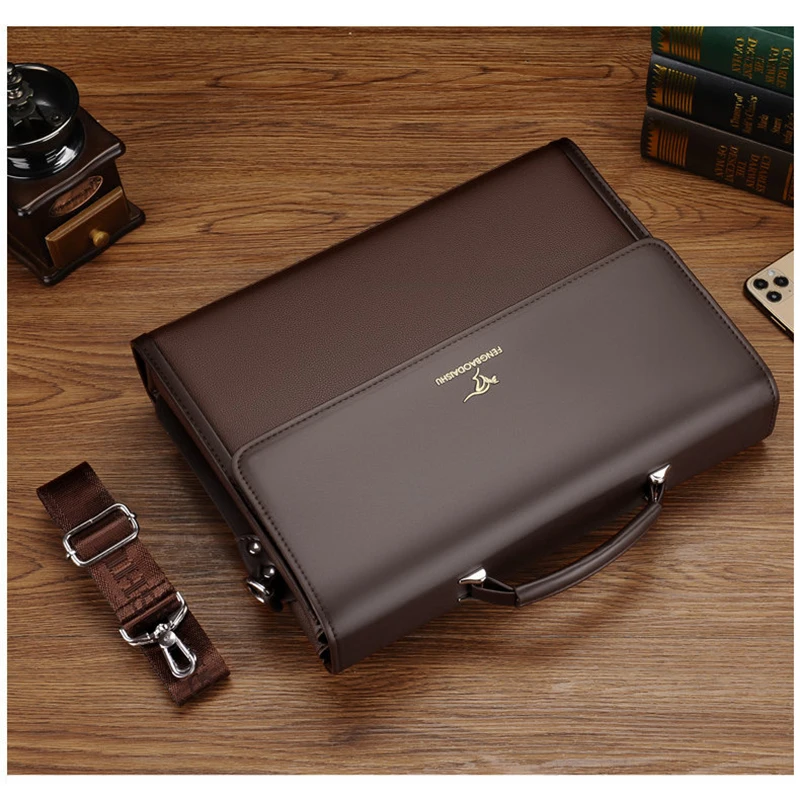
When to Seek Professional Leather Care
While regular maintenance and minor repairs can be handled at home, certain situations call for expert intervention. Knowing when to consult a professional can save a valuable briefcase from permanent damage.
Scenarios Warranting Professional Care
- Deep scratches that expose the underlying leather structure
- Significant color loss over a visible area
- Structural damage affecting corners or stress points
- Water or liquid damage that has caused stiffening or warping
- Mold or mildew development from improper storage
- Hardware issues that affect opening/closing mechanisms
- Stitching failures, especially along stress points
Finding Qualified Leather Specialists
When searching for professional leather care:
– Look for specialists with specific experience with fine leather goods rather than general shoe repair shops
– Request examples of previous briefcase restorations
– Inquire about their approach to color matching and repair techniques
– Ask whether they use water-based or solvent-based products (water-based is generally preferred)
Questions to Ask Before Service
- What specific techniques will be used for repair?
- Will the repair affect the finish or color of surrounding areas?
- How long will the repair process take?
- What care recommendations do you suggest after repair?
- Is there a guarantee on the work performed?
Cost vs. Replacement Considerations
Professional leather repair typically ranges from $50 for minor issues to $200+ for major restoration. When deciding between repair and replacement, consider:
– The original investment value of your briefcase
– Sentimental attachment and broken-in comfort
– Quality of materials compared to new replacement options
– Whether repair will restore both function and appearance
For premium pieces like our black leather briefcases, professional restoration often represents good value compared to replacing with equivalent quality.
Conclusion: The Reward of Diligent Leather Care
The time and attention invested in preventing scratches on your leather briefcase yields returns far beyond the immediate aesthetic benefits. A well-maintained leather briefcase serves as both a functional tool and a statement of professional commitment to quality and detail.
Prevention truly is simpler and more effective than repair. The comprehensive approach we’ve outlined—understanding leather properties, implementing daily handling best practices, establishing cleaning and conditioning routines, applying protective treatments, and storing properly—creates multiple layers of protection for your investment.
With consistent care, your briefcase will develop character rather than damage. The subtle patina that emerges over years of proper maintenance tells a professional story that mass-produced replacements simply cannot match. This natural evolution of appearance is part of what makes fine leather goods special—they improve rather than deteriorate with mindful use.
The relationship between owner and fine leather briefcase is reciprocal—the care you provide is returned through years of reliable service and distinguished appearance. By incorporating these preventive strategies into your routine, you’ll ensure your briefcase remains a trusted companion throughout your professional journey.
For those seeking exceptional quality that responds beautifully to proper care, Poise Porter’s collection of top-rated classic leather briefcases offers pieces crafted to stand the test of time.

